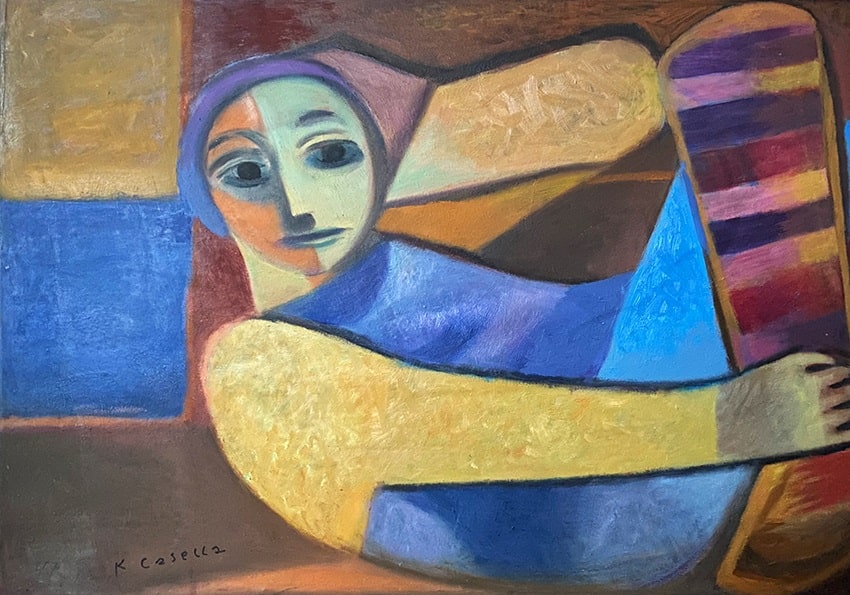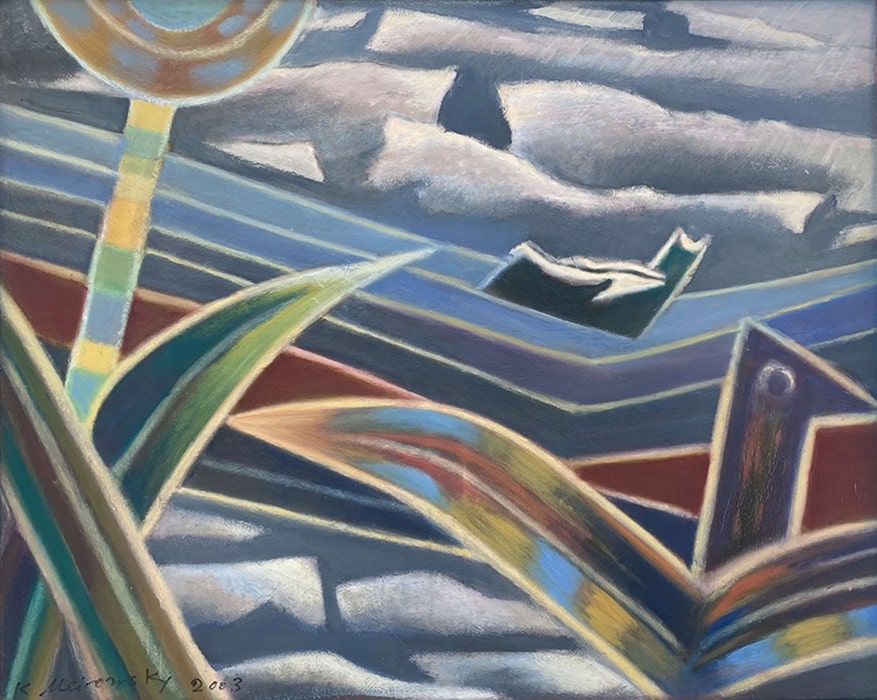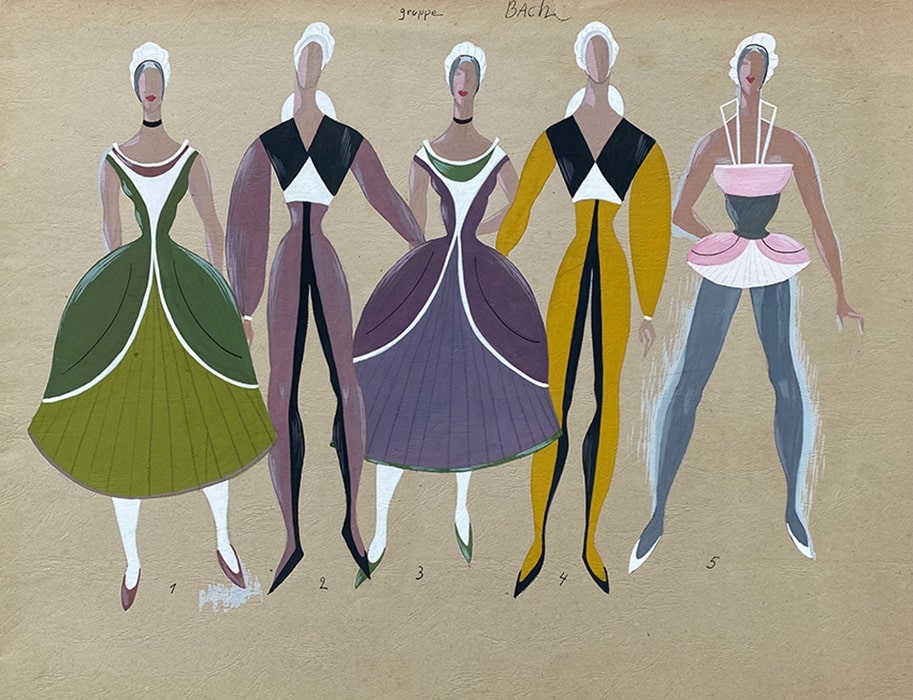Fundació Es Baluard Museu d’Art Modern i Contemporani de Palma presents the exhibition The Red Action and the Membrane from 31 May. Of all the modern artists who moved to the Balearic Islands after the Second World War and created a large part of their work there, Katja Meirowsky (Straussdorf, 1920 – Potsdam, 2012) has received some of the least attention from historiographers. Unjustly ignored, her work and her figure seem somewhat alien and anachronistic today, but are at the same time of great aesthetic significance. There is an urgent need to rethink the canon of modern art, expand its criteria and make room for “the other half of the avant-garde”.
Image above: Katja Meirowsky, Gruppe Bach, 1958, Gouache, 33 x 46 cm
Katja Meirowsky had both Russian and Italian ancestry (her maiden name was Casella) and was raised by a Jewish mother and communist father. Between 1938 and 1942 she studied painting at the institution currently known as the Universität der Künste Berlin (Berlin University of the Arts). During the Nazi era she was a member of the Rote Kapelle (Red Orchestra) resistance movement that aided Jews and others fleeing the Nazi regime. Wanted by the Gestapo, Meirowsky hid out in Poland during the war before returning to Berlin in 1945 to join the circle of artists around the Gerd Rosen and Bremer galleries.
In 1949 she teamed up with artist Alexander Camaro and his wife, Liselore Bergman, to found the artistic cabaret Die Badewanne (The Bathtub), whose members included, among many others, artists Hans Laabs and Heinz Trökes, whose paths she would later cross again on the island of Ibiza. Housed in the Femina-Bar in Berlin, Die Badewanne was a multidisciplinary hive of experimentation linking painting, literature, dance, theatre and music inspired by the literature and modern art rejected and censored by the Nazis, which these artists now reinterpreted and adapted to the present moment. Satire, irony, absurdism and dark humour were used to denounce the continuing presence of Nazism in postwar German society. Die Badewanne only lasted six short, albeit intense, months and in 1950 a group of some of these artists founded a new cabaret, Die Quallenpeitsche (The Jellyfish Whip), while Katja’s husband, Karl Meirowsky, her younger brother, Rolek Casella, and Hans Laabs created an alternative project, Das Atelier (The Studio).

Driven mainly by the urge to find her own voice as an artist, in 1952 Katja Meirowsky and her husband moved to build a new life and start over afresh, eager to free themselves from the weight of an anguished and violent past. There, in a setting that had welcomed utopias before the war, they hoped to be able to give themselves over completely to creative endeavours and invent a new world. Although she was a member of Grupo Ibiza 59—the sole woman in an eminently masculine milieu—Meirowsky lived an almost ascetic life, with limited social contact and surrounded by a small circle of friends. However, Karl and Katja Meirowsky developed a keen interest in archaeology and Karl was the first foreigner to be admitted into the Instituto de Estudios Ibicencos (Institute for Ibizan Studies). Karl’s energy and enthusiasm led them to take occasional trips around the Mediterranean or to the Americas and Asia.
At that time, Ibiza was a cultural exception in a poor country stifled by the constraints of a military dictatorship. It acted as a multicultural hub that attracted artists and creators of numerous nationalities, a hive of activity in literature and the visual arts with a number of galleries and, after 1969, one of the first contemporary art museums in postwar Spain.
Although Katja Meirowsky’s work was exhibited on Ibiza, mainland Spain, Germany and other European countries, her oeuvre has received little historical and critical attention. The show at Es Baluard Museu takes a new approach and a fresh perspective to convey a lifetime’s work that extended into the 21st century.

Meirowsky’s work almost sought to distance itself from the conventions that dominated the art of her time to occupy a space beyond it. From this outside vantage point, she was able to secure the strict individual creativity she required in response to an existence scarred by some of the most terrible and atrocious human barbarities of the first half of the 20th century: fascism, the holocaust, the second great war, totalitarianisms and the destruction of a world and a culture. We might say that Meirowsky painted through a process of elimination, by distilling general forms in a move to eschew the rigours of Cubism, to distance herself from the liquid condition of surrealist space and expressionist egos, the Tachisme and Informalism that dominated the postwar art market. Meirowsky drove her work along the path of abstraction, but almost always while performing delicate balancing acts between presenting prototheatrical spaces (her work includes stages, curtains and the like) and the surrounding nature, without ever forgetting the mark that humans leave behind on land and landscapes, culture and its traces.
Put together from work the artist kept over the course of her career, and meticulously conserved by her friends Marianne and Reinhard Lippeck in Potsdam, this show aims to explore the reasons behind the fascination her work inspires today. On the one hand, Meirowsky followed in the line of the avant-garde artists from the first half of the 20th century; on the other, her constant search for originality led her to explore visual paths that went in the opposite direction to the prevailing currents and fashions: she eschewed known styles and instead created iconographic constellations in which rationality is expressed in modestly muted colours to transmit practically ineffable emotions and ideas. Her painting doesn’t appear to have any external references: everything starts and returns to the same space shared unconsciously by creator and spectator.

In the words of Spanish poet Antonio Colinas, a great friend of Katja and Karl Meirowsky, “her work . . . is wise in both peace and threats, there is a tremendous metaphysical serenity and a sense of aggression, an inevitable provocation imposed by the sense of catastrophe in the time in which we happen to live”.
WHEN?
Exhibition period:
Friday, 31. May until Sunday, 25. August 2024
Opening:
Thursday, 30. May at 7 pm
Opening hours:
Tue – Sat, 10 am to 8 pm
Sun, 10 am to 3 pm
WHERE?
Fundació Es Baluard Museu d’Art Modern i Contemporani de Palma
Plaça de la Porta de Santa Catalina, 10
07012 Palma de Mallorca






